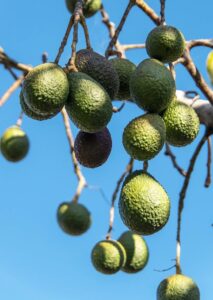
Edimental avocado an evolutionary enigma
By Clive Larkman
Last month we looked at a great garden plant that looks good, is easy to grow and has great use in the kitchen, Tasmannia lanceolata, an attractive large shrub that comes from SE Australia. Another equally attractive plant is the Avocado Tree (Persea americana) which is native to a small area in Central America between Central Mexico and Costa Rica. It evolved in the low mountains and valleys across the region. Being tropical, the temperature ranges were consistent and narrow, with minimum temperatures being in the mid-teens, and highs in the low thirties. Days are standard with daylight varying from 11 hours to 13 hours, and the sun consistently being high in the sky on the east/west axis.
This part of the world has around 1000 to 1500mm of rainfall in an average year. Mostly in the wet season but still with regular rain in the dry season. The biggest weather effect on plant growth is the occurrence of hurricanes and tropical storms. These generally occur from mid-summer to mid-autumn and can bring significant rain and wind events. However, they do not occur every year and can be both mild and severe. Drought, frost and burning suns are very rare and are not of any evolutionary interest to the plants.
The avocado tree is an evolutionary enigma in that it is believed to have been around in its natural environment for more than 10,000 years, and is believed to have been part of the hunter-gatherer’s diet of the early tribes in the southeastern corner of Mexico. Although this is not the only place the pits of the fruit have been found, it includes the Tehuacan Valley where a large amount of archaeobotanical research has been conducted. Along with the local maize and chilli plants, it is believed the avocado is one of the first domesticated plants.
The ability to domesticate and propagate plants is seen as one of the base requirements for a civilised culture. Without this ability people could not settle and live in sizeable communities; with it, they can bring food plants to them. With this skill they can select the best yielding forms. The obvious next step is the ability to selectively breed for better yields – larger, healthier, more flavour etc. There was already some natural evolution of forms due to the varying topography and climate zones between central Mexico and South America, and between the mountains and valleys and the flatter lowlands. It is believed that around 2,500 years ago the local tribes started their own breeding and several distinct forms of avocado became apparent.
There is some debate as to why the plant has large fruit with a single seed and why the fruit ripens off the tree. Some say it was an adaptation to hurricanes and severe storms causing the unripe fruit to fall and ripen when the weather was more conducive to germinating young plants. Others say it was due to the fruit being a key part of the diet of the giant sloths. They would pick the fruit, carry and eat it over weeks then deposit the seed ready to germinate well away from the parent plant.
The latter is an interesting concept as to why, but the fact that the giant sloths were important, ties in with the geological time scale. The plant first showed up around ancient human civilisations about 10,000 years ago. The giant sloths disappeared around the same time (it is postulated that the arrival of humans killed them off) when evidence of avocado domestication shows up. It would seem that the giant sloths were replaced by humans as the key means of seed dispersal.
The plants are hermaphrodites in that they produce both male and female flowers. However, they do not usually produce both flowers at the same time to help prevent inbreeding. This severely reduces the quantity of viable seed produced by the trees which makes it important the viable seed germinates when there is a high chance of successful growth. It also makes them hard to breed and reduces the natural variation in each generation. This in turn makes them slow to adapt to survival pressures from their natural environment, which could be why they adapted so quickly to human dispersal. As I said above – an enigma!
They are widely grown around the world and next month we will look at their requirements and the value of the fruit.
